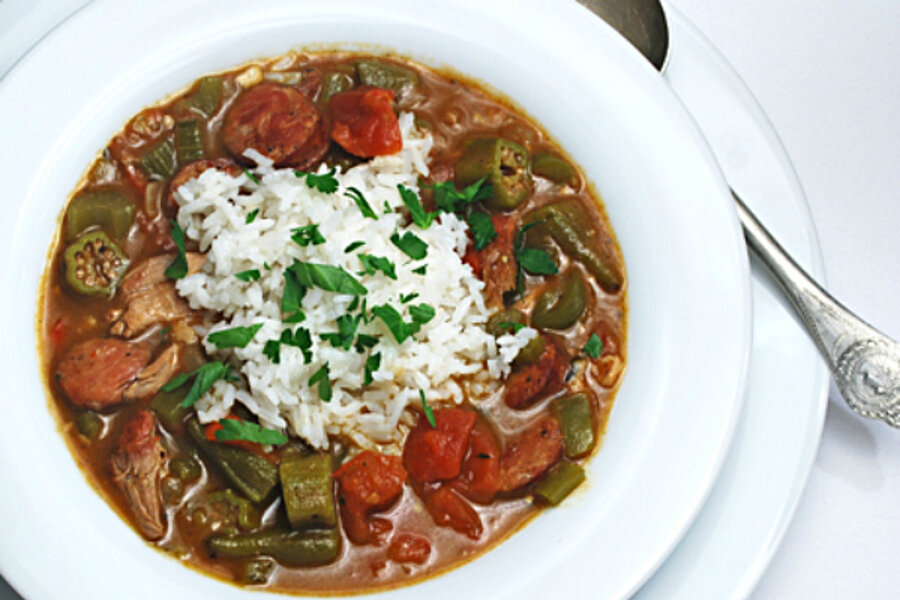This gumbo will carry you right to the heart of "the Bathtub" community in "Beasts of the Southern Wild" at the southern edge of the Delta.
By Terry Boyd, Blue Kitchen
Serves 4
2 whole duck legs (drumstick and thigh, about 1 pound total)
salt, freshly ground pepper
1/2 pound andouille sausage, cut into 1/2-inch slices
canola oil
1/4 cup all purpose flour
1 large onion, chopped (about 1 cup)
4 ribs celery, sliced (about 2 cups)
2 cups chopped bell pepper (I used a mix of red and green)
3 cloves garlic, finely chopped
2-1/2 cups reduced sodium chicken broth
1 cup water
1 14-1/2-ounce can diced tomatoes, with juices
1/4 teaspoon cayenne pepper
1/2 teaspoon dried oregano
1/2 teaspoon dried thyme
1/2 teaspoon sweet paprika
2 bay leaves
1/2 pound fresh okra (may substitute frozen – see Kitchen Notes)
1-1/2 teaspoons filé powder (optional – see Kitchen Notes)
cooked white rice
chopped Italian parsley, for garnish (optional)
Tabasco or other hot sauce (optional)
A quick tip: Chop the onion, celery, bell pepper and garlic before starting to cook the duck. It will make things easier – it will also make your kitchen smell like heaven right away.
Season the duck legs with salt and pepper and place them skin side down in a dry, unheated Dutch oven or heavy pot. Set the heat to medium-low and brown the duck on both sides, about 5 minutes per side. If the duck doesn’t release from the pot at 5 minutes, just let it cook a minute or so more and it will. Transfer the duck to a plate and add the andouille sausage. Brown just for 2 to 3 minutes, stirring occasionally and transfer to a bowl (or the plate with the duck legs).
Make the roux. Survey the fat in the bottom of the pot. There probably won’t be more than a tablespoon or so (duck legs have much less fat than duck breasts do). Add 3 tablespoons or so of canola oil to the pot, enough to give you about 1/4 cup of fat. Raise the heat to medium and add the flour all at once. Whisk the flour into the oil to combine and continue whisking to prevent burning. My favorite tool for this is aDIREKT whisk we bought at IKEA more than five years ago. I’m not sure they still carry it, but I think they have something similar.
After 5 minutes or so, the roux will start to take on a blond hue. Continue whisking and cooking. If your roux starts to smoke, reduce the heat slightly. Eventually, the roux will turn a nice deep brown; mine took about 15 minutes to get to that point, but it can take longer.
When the roux reaches a satisfying brownness, add the onion. Toss to coat with the roux and stir frequently (you can switch to a wooden spoon or pair of wooden spatulas – I like the latter because as you add more stuff to the pot, it’s easier to mix it all together). Cook the onion for about 5 minutes, then stir in the celery, bell pepper and garlic. Cook, stirring occasionally, for another 3 to 4 minutes.
Add the chicken broth, water and diced tomatoes with their liquids to the pot. Add the cayenne pepper, oregano, thyme, paprika and a generous grind of black pepper and stir to combine. Return the duck legs and sausage to the pot, along with any accumulated juices. Tuck the bay leaves into the liquid and bring gumbo to a boil. Reduce heat and simmer, covered, for 1 hour.
Transfer the duck legs to a plate and allow them to cool enough to handle. Cover the pot and let the gumbo continue to simmer. Meanwhile rinse the okra, trim off the tops and slice into half-inch or so pieces. After 10 or 15 minutes, remove the skin from the duck legs and cut/tear the meat from the bones. It will still be pretty warm, so be careful, but don’t be a baby about it, either. Cut the meat into bite-sized chunks and add the duck and the okra to the pot.
Cover and simmer for another 45 minutes. Taste and adjust seasonings. I know that 1/4 teaspoon of cayenne sounds tame, but the andouille sausage will add some heat. Add more cayenne if you like or some hot sauce. As the gumbo nears doneness, cook the rice. Remove the gumbo from the heat, discard bay leaves and stir in the filé powder, if you’re using it.
Serve the gumbo in shallow soup bowls. Top with a generous mound of rice and sprinkle with chopped parsley. Pass the hot sauce around the table for those who want more heat and a vinegary zip.
Kitchen Notes
Don’t skip the okra. Okra is a classic southern vegetable that found its way here from Africa. We love it steamed, fried or however. Some people object to its “sliminess,” but that viscous liquid cooks into the broth and helps thicken it. When shopping, avoid overly large okra, as it can be woody. If you can’t find acceptable fresh okra, frozen will do just fine.
Filé powder. This is another staple of Creole and Cajun cooking. Also known as gumbo filé, it is the powdered leaves of sassafras trees. It is used sparingly as a thickening agent and should be stirred into gumbo after it’s removed from the heat; otherwise, it can make the broth stringy. Besides thickening the broth, it adds a kind of root beer flavor. As you see, my recipe calls for all three thickening agents, roux, okra and filé powder. Feel free to omit the filé powder. If you’re looking for a source, we got ours at the The Spice House.







